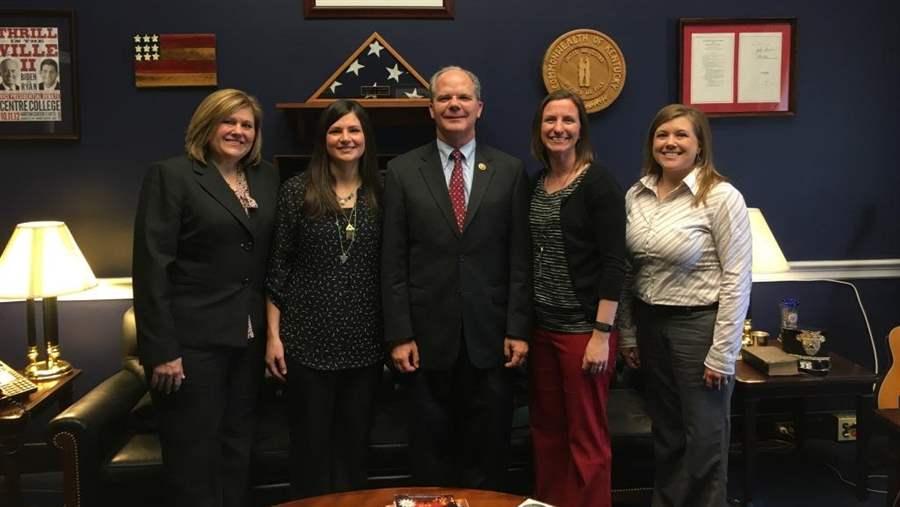School Leaders Ask Congress to Pass Child Nutrition Bill
 © Amy Oliver
© Amy OliverRepresentative Brett Guthrie (R-KY) meets with Kentucky school leaders (from left) Gina Howard, Heather Bushelman, Amy Oliver, and Kristy Hodges, to discuss how renewing the Child Nutrition Act would help them continue to serve healthy meals to students.
Eighty-two child nutrition leaders from across the country traveled to Washington on Feb. 22 and 23 to seek support for school meal programs. The group met with almost 100 congressional members and staff to share success stories from their home districts and to help policymakers understand why it is so important for them to reauthorize school nutrition programs this year.
Before visiting Capitol Hill with his message, Bertrand Weber, director of culinary and nutrition services for the Minneapolis Public Schools, shared his story with FOX 9 in Minneapolis: “In any business, you need stability. In our school system, we start planning now for what we’re going to put on our menu next year so we can start planning for resources.”
School leaders asked members of Congress to incorporate the following three measures in the reauthorization of the Child Nutrition Act:
- Maintain science-based nutrition standards for school foods.
- Support school kitchen equipment and infrastructure needs.
- Ensure that school food service professionals have access to adequate training and technical assistance.
 © The Pew Charitable Trusts
© The Pew Charitable TrustsMinnesota Senator Amy Klobuchar (back to camera) meets with (from left) Tim Lutz, superintendent at Kelliher Public School; Karyn Lutz, a registered dietician with Northwest Service Cooperative; and Bertrand Weber, food service director for the Minneapolis Public Schools, to discuss the importance of science-based nutrition standards.
Nutrition standards for school meals and snacks were strengthened in 2012, and policymakers working on the law’s reauthorization are considering whether to revise these rules. Eight in 10 Minnesota voters favor the current meal standards, and other national and state polls have found similarly high levels of support for healthier school food guidelines.
In January, the Senate Agriculture, Nutrition, and Forestry Committee unanimously approved a bipartisan bill that would reauthorize the National School Lunch Program and School Breakfast Program for five years. The next step for the bill is passage by the full Senate. In the House, the Education and the Workforce Committee oversees the reauthorization process and is working on its own bill.
Like other educators, school nutrition personnel require modern tools and ongoing training. Most districts across the nation need kitchen equipment and training opportunities to prepare their workforces to run complex meal programs successfully. The Senate’s draft bill includes language from the School Food Modernization Act, proposed bipartisan legislation that would help establish a loan program, provide targeted grant assistance to schools, strengthen training, and offer technical assistance for school food service personnel.
 © The Pew Charitable Trusts
© The Pew Charitable TrustsSenator John Boozman (R-AR) meets with Arkansas school nutrition leaders (from left) Destiny Schlinkler, Emily English, Mary Miller, and Rachel Spencer to discuss the importance of prioritizing training and kitchen equipment in the Child Nutrition Act reauthorization. The School Food Modernization Act is bipartisan legislation that would provide resources for schools to improve kitchen equipment, infrastructure, and personnel training.
Recent data from the U.S. Department of Agriculture show that 97 percent of schools across the country are meeting the updated standards, and multiple studies confirm that kids are choosing and eating more of those healthier foods.
Reflecting on the visit to Congress, Tazeen Chowdhury, food service director for the Mount Lebanon School District in Pennsylvania, told WESA 90.5, Pittsburgh’s NPR news station: “By actually going [to Washington] and telling our success stories, we’ve been able to prove that these regulations do work and keeping children’s health in the forefront is the biggest priority.”











